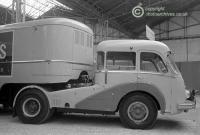DAF

Hubertus Josephus and Willem Antonius Vincentiusvan Doorne brothers opened in the former brewery in Eindhoven a machine shop on April 1, 1928, where they collected metal cabinets, windows and stairs. Soon they began to manufacture horse, tractor, and finally, car trailers. Since 1932 the company became known as the "Factory of trailers van Doorn brothers" (Van Doorne's Aanhangwagenfabriek), abbreviated to DAF, and since 1934 specialized of producing automotive trailers with four rear wheels. In 1936, DAF began to modify cars and two-axle trucks in variants with the wheel configuration of 6x4, replacing the conventional rear axle by 2-axle bogie Trado, which received its name from combining the first letters of the names of the engineers Von der Trappen and brothers Doorne. The first DAF vehicle - the army amphibious MC139 - was presented the same year.
By the early 50s the producing lineup consisted of four basic models with capacities from 3 to 6 tons with American 4- and 6-cylinder gasoline and diesel engines Hercules. The volume of production increased from 150 trucks in 1949 to 3,100 units in 1954. In 1958, DAF brand received a new meaning: the company was renamed to automobile producer and called 'Van Doorne's Automobile Fabriek'. In that year, DAF presented a small passenger car DAF 600.
The worsening of environmental problems caused DAF in 1971 in the so-called "Club of Four", which also included companies Magirus-Deutz, SAVIEM and Volvo, which led to the creation of a new range of trucks with an attractive unified Club cabin. To expand the program and enter new markets in November 1971 DAF signed an agreement with International Harvester. As a result, in 1973 the program included a heavy construction bonnet truck NAT2505, which was an American Paystar-5000 with Dutch diesel DKA1160.
Since 1978, DAF introduced terminal tractors, and since 1979 has stopped production of trailers. However, the energy crisis caused DAF to sell in 1976 its passenger cars business to Swedish company Volvo, which made it possible to concentrate only on truck producing. As a result, in 1979 production exceeded 15 thousand units, including one thousand buses, and in 1980 the company celebrated the release of 200 thousandth truck. By that time the company on plants in Holland and Belgium employed 9.1 thousand people.


